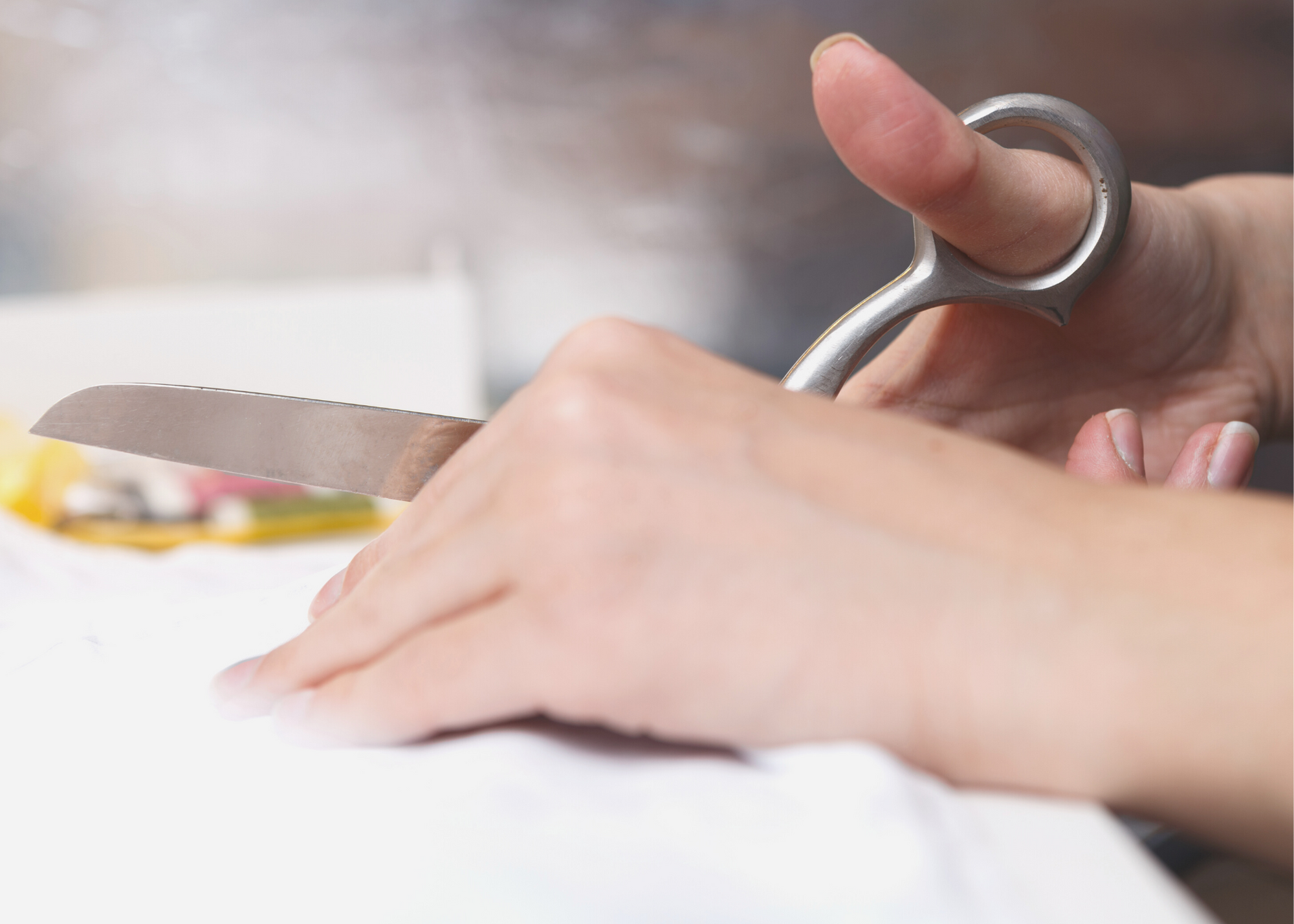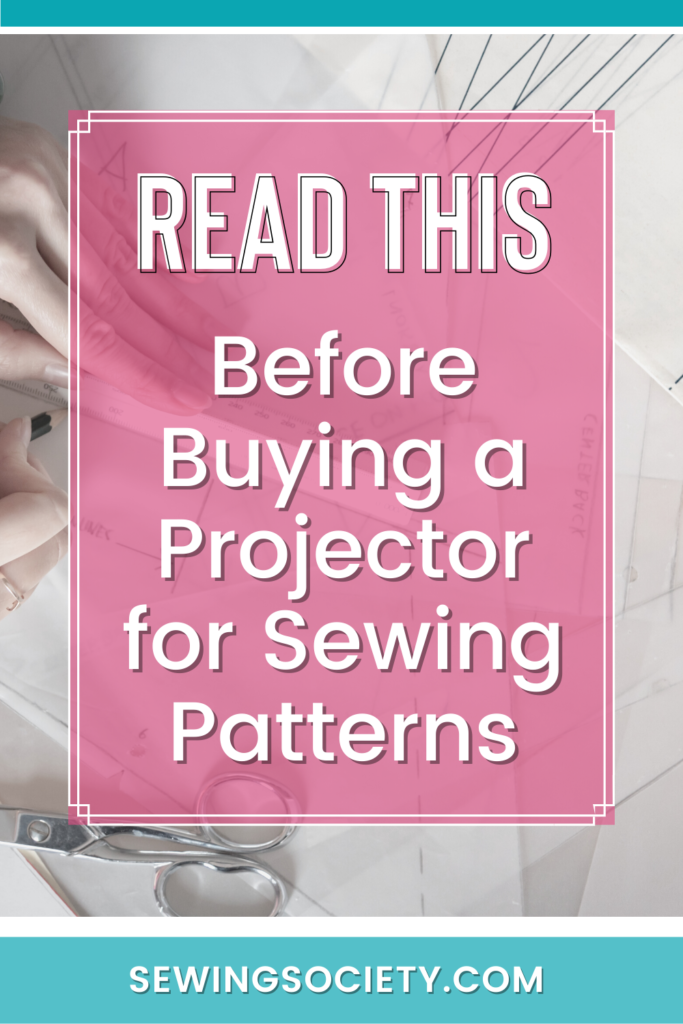Disclosure: This post may contain affiliate links. I earn a small commission when you click a link and make a purchase. Thanks for supporting SewingSociety.com!
If you are a member of any sewing community, I’m sure you’ve heard people talking about projector sewing patterns…
With a projector, you no longer need a paper pattern — you simply project the image of a pattern onto your fabric and cut it out.
Sounds pretty cool, right?
Projector sewing patterns save you so much time and money! You don’t have to buy paper and ink for printing or spend time taping your patterns together before you can use them.
If that sounds amazing to you, you need to get a sewing pattern projector!
Many indie pattern companies package projector files with their PDF patterns. Of course, you can technically use any A0 file (copy shop) with your sewing pattern projector; it just requires a little modification with a program like PDFStitcher.
Also Read: Where to Get Sewing Patterns for Projectors
Projectors are normally used to project an image on a vertical surface, such as a wall. However, when you flip a projector upside down and hang it from the ceiling, you can project an image downwards, which is perfect for a large cutting mat!
There is a little bit of work to get a projector set up for sewing patterns, but once it is calibrated, you will be VERY happy!
Which Type of Projector is Best for Your Sewing Room?
JOANN Fabric just launched the Ditto, a projector specifically for sewing patterns. It comes with a bar and clamps that you attach directly to a table. It is nice because it takes all of the guesswork out of setting up a projector for sewing. However, you’re limited to Ditto patterns only. If you want to use patterns from indie designers with a projector, you’ll need to buy a mini projector or a short-throw projector.
Ultra short throw projects sit on a table next to your cutting mat, whereas mini projectors hang on the ceiling or a wall. You’ll need to decide which option is best for your sewing space…
Measure from the ceiling of your sewing room down to your cutting mat. If the distance is less than 62”, then your only option is an ultra-short throw projector. (Unfortunately, that’s the more expensive option.)
Mini Projectors that hang from your ceiling need about 51” from the lens to the mat — you should add on an extra 10” to accommodate the projector itself and the ceiling mount (62″ total).
Other Features to Look for in a Projector for Sewing Patterns
Projectors for sewing patterns come in a wide range of prices. You can expect to pay upwards of $600 for a good one, especially if you need to get an ultra short throw model. However, you can find mini projectors for under $100 if you look hard enough or wait for a sale.
Here are some other features to look at:
- Lumens Rating: The higher the lumens rating, the brighter the projector will be. This may be important to know if you plan on using your projector in a room with a lot of light. Bright rooms make it harder to see the projected image.
- Native Resolution: The higher the resolution on your projector the better. This will ensure you have a sharp image. Even if the file has a better resolution, it will not show sharply if the projector’s resolution is low.
- Keystone: Some projectors have a feature to reduce distortion when projecting at an angle. Usually this is a knob on the projector that helps tilt the image if the projector has to be hung at a slight angle. This can be very helpful for wall or ceiling mounted projectors.
- Power Source: Some projectors take batteries while others are plugged in. Batteries may be nice if you do not want a lot of cords around; however, if you have to change or charge batteries often then that could take your projector out of calibration, which will have to be readjusted. If you have a permanent fixed projector on your ceiling or wall, recalibrating can get annoying.
- Wi-Fi: Some projectors can connect to Wi-Fi while others have to be plugged into a computer.
- Remote Controls: Having a remote can be nice, especially if your projector is mounted to a ceiling. Remotes not only can power a projector on and off (so you don’t have to manually do this from the ceiling mount), but they can also have menu features such as flipping or mirroring images, which may become helpful with cutting certain patterns.
- Size: Projectors come in many sizes. Short throw projectors are usually large and bulky, which may not be something that you want laying around all the time on your sewing table.
Pros and Cons of Ultra Short Throw Projectors
Ultra short throw projectors are useful for those that have less than 62” clearance from ceiling to cutting mat. They are also good for those that do not have a permanent sewing space or may not want to drill holes in their wall or ceiling. Ultra short throw projectors are easy to move around or put away if needed. These projectors just sit on a table with your cutting mat.
One of the biggest downsides of ultra short throw projectors is their price. New ones can be quite expensive, and the replacement bulbs can also be a lot of money. You may be able to find a used one, but then you have the concern of it working well with no warranty. Another thing is each time your projector is moved, it has to be recalibrated, which takes time and patience. Some people also complain about the size of these projectors — they can be fairly big.
Pros and Cons of Mini Projectors
Mini projectors are usually more affordable and more user friendly than ultra short throws. The simple design of mini projectors makes them a favorite among sewists. In addition, they can be permanently set up, which means less recalibrating.
The downside to mini projectors is that not every sewing space can accommodate one, especially if your ceiling to mat distance is short. Another thing is that they are usually mounted on a wall or ceiling, which some people may not like having as a permanent fixture.
Reviews of Popular Projectors for Sewing Patterns
Nobody has invented a projector specifically for sewing patterns yet — let’s work on that — but almost any short-throw projector will work. Here are a few good options:
Most Popular Projector for Sewing Patterns: Vivimage Explore 2
The Vivimage Explore 2 is probably the most popular projector among sewists. It is affordable and user friendly. You can sometimes find it on sale for under $100. The Explore 2 is Wi-Fi capable or can be connected to your computer with an HDMI or USB cord. It also comes with a remote that is helpful when flipping images. The keystone knob on the projector helps focus images quickly, even those on a slant, and once focused does not have to be adjusted again. Many people have been pleasantly surprised with the bigger projection than expected. The image is not as bright as a short throw projector, but it still works fine in a daylit room.
If you can’t find a Vivimage Explore 2, the VANKYO 470 Leisure projector has similar features and quality.
Most Budget Friendly Projector: Apeman LC350
The Apeman LC250 is one of the most affordable projectors, being around $70. Just like the Vivimage, it does have to be mounted on the ceiling or wall for patterns to be cut. The light is not as powerful, which makes it a bit more difficult to see patterns in rooms with a lot of daylight. Some have complained about the image quality being a bit blurry and the loud fan; however, if you are able to cut in a more dim room, then this projector is definitely affordable for a beginner projector for sewing patterns.
Most Popular Ultra Short Throw Projector: Epson BrightLink 485WI
The Epson BrightLink 485WI is more compact and portable compared to other bulky short throw projectors. With just the touch of an interactive pen, this projector can automatically calibrate itself, which can be very helpful. The projector is rated to have 3100 lumens, which means that even in bright rooms you will be able to see the pattern on your fabric. The projector can either be mounted or can project from a table. While the projector itself can be expensive, the maintenance is relatively inexpensive compared to other short throw projectors.
Do you have any other advice to offer someone looking to get a projector for sewing patterns? Leave your suggestions in the comments below.
Share this post on Pinterest!







Do you know if Vivage Explorer 2 could sit on top of an armoire to cast onto the cutting table?
I have purchased an epson Brightlink 485 WI but am not sure how to calibrate it to a small size to fit my sewing table
I can’t find a Vivage 2 explore. They are out of stock everywhere. What is a good equivalent?
Vankyo, the sister brand of Vivimage, has some projectors.
https://sewingsociety.com/review-of-the-vankyo-leisure-470-projector-for-sewing/
Good Night,
Can Ditto Sewing Projector be used in South
America?